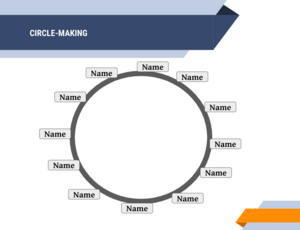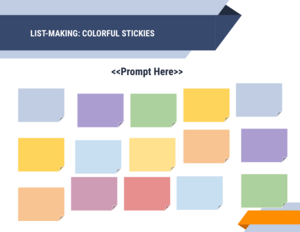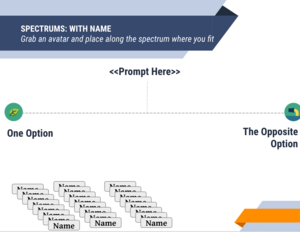Facilitation 101: Difference between revisions
No edit summary |
|||
| (2 intermediate revisions by the same user not shown) | |||
| Line 1: | Line 1: | ||
This page was created to provide tips and suggestions for activists related to facilitating meetings and events. This guide reflects several questions the HUB community has raised on facilitation. | This page was created to provide tips and suggestions for activists related to facilitating meetings and events. This guide reflects several questions the HUB community has raised on facilitation. | ||
<br> | <br> | ||
The information included comes from existing organizer databases and resources and advice from movement thinkers. A special thanks to HUB advisor [https://www.amarapossian.com/ Amara Possain], who thoughtfully shared their expertise with the HUB team. Their knowledge is shared throughout. We encourage readers to share further ideas on how this page can be expanded upon and improved. | The information included comes from existing organizer databases and resources and advice from movement thinkers. A special thanks to HUB advisor [https://www.amarapossian.com/ Amara Possain], who thoughtfully shared their expertise with the HUB team. Their knowledge is shared throughout. We encourage readers to share further ideas on how this page can be expanded upon and improved. | ||
<br> | <br> | ||
<br> | <br> | ||
This guide includes... definers of good vs bad facilitation, tools for good facilitation ( | This guide includes... definers of good vs bad facilitation, tools for good facilitation (in preparation, the beginning of meetings/events, for idea discussion and clarifying and suggestions for increasing participant engagement), suggestions for managing group dynamics and some suggestions specifically for online facilitation. | ||
= What do we mean by facilitation? <ref>https://www.trainingforchange.org/training_tools/meeting-facilitation-the-no-magic-method/</ref> <ref>https://www.seedsforchange.org.uk/facilitationmeeting</ref> | = What do we mean by facilitation? <ref>https://www.trainingforchange.org/training_tools/meeting-facilitation-the-no-magic-method/</ref> <ref>https://www.seedsforchange.org.uk/facilitationmeeting</ref> = | ||
The role of a facilitator is to drive meeting or event participants towards clarity. Facilitation move things forward and build momentum. Facilitators also bring participants back to the purpose of the event/meeting. Remembering your purpose is key, so that when someone is taking up too much space, the facilitator can remind that you'd like to bring us back to the purpose and our goals. -Amara Possain, HUB advisor | The role of a facilitator is to drive meeting or event participants towards clarity. Facilitation move things forward and build momentum. Facilitators also bring participants back to the purpose of the event/meeting. Remembering your purpose is key, so that when someone is taking up too much space, the facilitator can remind that you'd like to bring us back to the purpose and our goals. -Amara Possain, HUB advisor | ||
<br> | <br> | ||
<br>In other words, the role of a facilitator and the purpose of facilitation is to <ref>https://www.trainingforchange.org/training_tools/meeting-facilitation-the-no-magic-method/</ref> | <br>In other words, the role of a facilitator and the purpose of facilitation is to <ref>https://www.trainingforchange.org/training_tools/meeting-facilitation-the-no-magic-method/</ref> <ref>https://www.seedsforchange.org.uk/facilitationmeeting</ref> : | ||
{| class="wikitable" style="font-size: 14.4px; width: 46.186%; height: 185px; border-color: rgb(0, 0, 0);" | {| class="wikitable" style="font-size: 14.4px; width: 46.186%; height: 185px; border-color: rgb(0, 0, 0);" | ||
|- style="height: 37px;" | |- style="height: 37px;" | ||
| Line 59: | Line 59: | ||
*Miscommunications / inability to diagnose where we departed in understanding | *Miscommunications / inability to diagnose where we departed in understanding | ||
== Key facilitation skills <ref>https://www.seedsforchange.org.uk/facilitationmeeting</ref> | == Key facilitation skills <ref>https://www.seedsforchange.org.uk/facilitationmeeting</ref> == | ||
| Line 76: | Line 76: | ||
= Tools for good facilitation = | = Tools for good facilitation = | ||
The following sections include a compilation of suggestions from Seeds for Change''' <ref>https://www.seedsforchange.org.uk/facilitationmeeting</ref> '''''', '''Amara Possain (HUB advisor), Daniel Hunter (350.org training director) <ref>https://trainings.350.org/resource/online-monster-manual/</ref> , the Anarchist Library <ref>https://theanarchistlibrary.org/library/c-t-butler-and-amy-rothstein-on-conflict-and-consensus-a-handbook-on-formal-consensus-decisionm#toc76</ref> , Berit Lakey (Training for Change) <ref>https://www.trainingforchange.org/training_tools/meeting-facilitation-the-no-magic-method/</ref> , Change Agency <ref>https://commonslibrary.org/diagnostic-tools-for-trainers-and-facilitators/</ref> , Adrienne Maree Brown <ref>https://www.akpress.org/emergentstrategy.html</ref> and Rhizome <ref>https://commonslibrary.org/facilitation-tools-and-techniques/</ref> . Suggestions are relevant to virtual, in-person and hybrid meetings and events. | The following sections include a compilation of suggestions from Seeds for Change''' <ref>https://www.seedsforchange.org.uk/facilitationmeeting</ref> '''''', '''Amara Possain (HUB advisor), Daniel Hunter (350.org training director) <ref>https://trainings.350.org/resource/online-monster-manual/</ref> , the Anarchist Library <ref>https://theanarchistlibrary.org/library/c-t-butler-and-amy-rothstein-on-conflict-and-consensus-a-handbook-on-formal-consensus-decisionm#toc76</ref> , Berit Lakey (Training for Change) <ref>https://www.trainingforchange.org/training_tools/meeting-facilitation-the-no-magic-method/</ref> , Change Agency <ref>https://commonslibrary.org/diagnostic-tools-for-trainers-and-facilitators/</ref> , Adrienne Maree Brown <ref>https://www.akpress.org/emergentstrategy.html</ref> and Rhizome <ref>https://commonslibrary.org/facilitation-tools-and-techniques/</ref> . Suggestions in these sections are relevant to virtual, in-person and hybrid meetings and events. | ||
== For meeting/event preparation == | == For meeting/event preparation == | ||
| Line 124: | Line 124: | ||
== For opening and beginning the meeting/event == | == For opening and beginning the meeting/event == | ||
{| class="wikitable" style="border-collapse: collapse; width: 86.5316%; height: 431px; background-color: rgb(255, 255, 255);" | {| class="wikitable" style="border-collapse: collapse; width: 86.5316%; height: 431px; background-color: rgb(255, 255, 255);" | ||
|- style="height: 23px;" | |- style="height: 23px;" | ||
| style="width: 11.5738%; background-color: rgb(153, 225, 217); height: 23px;" | <span style="color: rgb(0, 0, 0);">'''Build trust and ground attendees'''</span> | | style="width: 11.5738%; background-color: rgb(153, 225, 217); height: 23px;" | <span style="color: rgb(0, 0, 0);">'''Build trust and ground attendees'''</span> | ||
| Line 146: | Line 146: | ||
| style="width: 11.5738%; background-color: rgb(153, 225, 217); height: 262px;" | <span style="color: rgb(0, 0, 0);">'''Try the circle up tool!'''</span> | | style="width: 11.5738%; background-color: rgb(153, 225, 217); height: 262px;" | <span style="color: rgb(0, 0, 0);">'''Try the circle up tool!'''</span> | ||
| style="width: 67.9556%; height: 262px;" | | | style="width: 67.9556%; height: 262px;" | | ||
*<span>You might also try using the circle up tool. It helps people now who is in the room. It can be used for things like introductions.</span> | *<span>You might also try using the circle up tool. It helps people now who is in the room. It can be used for things like introductions, and during discussions if you wish to use go-arounds.</span> | ||
*<span>As facilitator, you might mark down each time someone speaks, so you can identify who is taking up lots of space vs who can specifically be called on to share their thoughts (ensuring less dominant speakers/personalities get speaking time).</span> | |||
<span></span>[[File:Screen Shot 2023-07-07 at 11.00.34 AM.png|300x300px|center|border]] | <span></span>[[File:Screen Shot 2023-07-07 at 11.00.34 AM.png|300x300px|center|border]] | ||
|} | |} | ||
| Line 175: | Line 176: | ||
| style="width: 21.7495%; background-color: rgb(197, 31, 132); border-color: rgb(0, 0, 0);" | <span style="color: #ffffff;">'''Stacking'''</span> | | style="width: 21.7495%; background-color: rgb(197, 31, 132); border-color: rgb(0, 0, 0);" | <span style="color: #ffffff;">'''Stacking'''</span> | ||
| style="width: 64.9343%;" | | | style="width: 64.9343%;" | | ||
*Those who want to speak can signal the facilitator, who would add the person’s name to a list of those wishing to speak, and call on them in that order. This can be, for example, dropping a * in the chat virtually, or recording those who raise their hands. | *Those who want to speak can signal the facilitator, who would add the person’s name to a list of those wishing to speak, and call on them in that order. This can be, for example, dropping a * in the chat virtually, or recording those who raise their hands in-person. | ||
*If many people want to speak at the same time, it is useful to ask all those who would like to speak to raise their hands. Have them count off, and then have them speak in that order. At the end of the stack, the facilitator might call for another stack. | *If many people want to speak at the same time, it is useful to ask all those who would like to speak to raise their hands. Have them count off, and then have them speak in that order. At the end of the stack, the facilitator might call for another stack. | ||
|- | |- | ||
| Line 181: | Line 182: | ||
| style="width: 64.9343%;" | | | style="width: 64.9343%;" | | ||
*Sticky notes (virtual on slides or in-person) can be used to allow participants to share ideas. | *Sticky notes (virtual on slides or in-person) can be used to allow participants to share ideas. | ||
*You can ask people to leave their names and/or identify specific sticky notes you want to discuss together (rather than waiting for someone to speak to their ideas). | |||
[[image:Screen Shot 2023-07-07 at 11.05.40 AM.png|300x300px|center|middle|border]] | [[image:Screen Shot 2023-07-07 at 11.05.40 AM.png|300x300px|center|middle|border]] | ||
|- | |- | ||
| Line 353: | Line 355: | ||
|} | |} | ||
= Specific suggestions for online facilitation <ref>https://commonslibrary.org/getting-started-with-online-training-and-facilitaiton/</ref> <ref>https://bethkanter.org/facilitate-virtual-meet</ref> <ref>https://futuregroundnetwork.org/resource/how-to-facilitate-a-zoom-meeting/?wpdmdl=183&refresh=639b7fa7ce8fd1671135143</ref> | = Specific suggestions for online facilitation <ref>https://commonslibrary.org/getting-started-with-online-training-and-facilitaiton/</ref> <ref>https://bethkanter.org/facilitate-virtual-meet</ref> <ref>https://futuregroundnetwork.org/resource/how-to-facilitate-a-zoom-meeting/?wpdmdl=183&refresh=639b7fa7ce8fd1671135143</ref> = | ||
{| class="wikitable" style="font-size: 14.4px; width: 87.2467%; height: 392px; border-color: rgb(0, 0, 0);" | {| class="wikitable" style="font-size: 14.4px; width: 87.2467%; height: 392px; border-color: rgb(0, 0, 0);" | ||
Latest revision as of 15:15, 25 October 2023
This page was created to provide tips and suggestions for activists related to facilitating meetings and events. This guide reflects several questions the HUB community has raised on facilitation.
The information included comes from existing organizer databases and resources and advice from movement thinkers. A special thanks to HUB advisor Amara Possain, who thoughtfully shared their expertise with the HUB team. Their knowledge is shared throughout. We encourage readers to share further ideas on how this page can be expanded upon and improved.
This guide includes... definers of good vs bad facilitation, tools for good facilitation (in preparation, the beginning of meetings/events, for idea discussion and clarifying and suggestions for increasing participant engagement), suggestions for managing group dynamics and some suggestions specifically for online facilitation.
What do we mean by facilitation? [1] [2]
The role of a facilitator is to drive meeting or event participants towards clarity. Facilitation move things forward and build momentum. Facilitators also bring participants back to the purpose of the event/meeting. Remembering your purpose is key, so that when someone is taking up too much space, the facilitator can remind that you'd like to bring us back to the purpose and our goals. -Amara Possain, HUB advisor
In other words, the role of a facilitator and the purpose of facilitation is to [3] [4] :
|
Take responsibility for helping the group stay on track and move through the agenda within the available time. |
|
Suggest how to move the group forward, rather than making decisions or plans for the group. |
|
Regulate the flow of discussion. |
|
Track decisions and milestones, providing clarity on the group's journey, clarifying and summarizing points. |
|
Prioritize the collective needs and goals of the group over individual within the group. |
Note: A person who has strong opinions or significant investment in the decisions being made may find it challenging to facilitate effectively. In some situations, it can be helpful to have an external facilitator.
What makes for poor facilitation?
The following reflections were raised by CAN-RAC and HUB team members in a joint workshop developed and delivered by Amara Possain:
- No agenda, no steering, lack of organization
- Repetition
- Lack of momentum
- Not stepping in to help pull out the positives (groups tend to focus on negatives)
- Not stepping in when some people are taking up too much space
- Not knowing the audience and how to tailor facilitation
- Not stepping in to get people back on track, when people hijack space
- Low engagement and energy, lack of initiative
- Not being able to move past certain items
- People weaponizing meeting rules and knowledge of process
- Passive aggressiveness
- Unclear roles in non-hierarchical structure
- Interrupting each other
- “Outfacilitating" the facilitator - often around an unbalanced power dynamic
- Miscommunications / inability to diagnose where we departed in understanding
Key facilitation skills [5]
- Active listening enables us to hear what others are saying;
- Questioning helps clarify what people are saying, or supports people to explore their needs and come up with new possibilities;
- Summarising helps remind us of the key points in the discussion and check we have the same understanding;
- Synthesising is the skill that allows us to draw together different views and ideas to form one proposal that works for everyone.
Good facilitation should result in good meetings with [6] :
- Clearly defined and mutually understood goals.
- A well-defined process for effectively achieving those goals.
- Recognition that participants bring their personal preoccupations and emotions alongside their interest in the subject matter.
- Fostering a sense of involvement and empowerment, allowing participants to feel ownership over the decisions and able to take necessary actions.
Tools for good facilitation
The following sections include a compilation of suggestions from Seeds for Change' [7] ', Amara Possain (HUB advisor), Daniel Hunter (350.org training director) [8] , the Anarchist Library [9] , Berit Lakey (Training for Change) [10] , Change Agency [11] , Adrienne Maree Brown [12] and Rhizome [13] . Suggestions in these sections are relevant to virtual, in-person and hybrid meetings and events.
For meeting/event preparation
| Stop and P-O-P [14] |
|
| Collect accessibility needs |
|
| Timing |
|
| Ordering items and modes of participation |
|
| Example agenda (for meetings) | -Welcome (honour the land, place and people) 5-10 minutes -Introductions 10-15 minutes -Overview of goals, agenda, agreements -Framing: Why us, here and now? -Brainstorming discussion -Harvesting ideas -Meaning making -Closing with appreciations for each other and the land |
| Circulate for feedback | |
| Engage rather than talking-at |
|
For opening and beginning the meeting/event
| Build trust and ground attendees |
|
|
Review as a group |
|
| Engage people early and often - set the tone in the first few minutes |
|
| Try the circle up tool! |
 |
For discussion and idea raising
For specifying/clarifying details
| Mainstream/margin |
|
| Maximize/minimize |
|
| Summarizing |
|
For information on how to facilitate decision-making processes, see the following pages:
- Consensus decision making 101
- Consensus decision making (suggestions for small groups)
- DARCI decision making framework
- Modified consensus decision making (suggestions for large and small groups)
For feedback
For ending meeting/events
- Make sure you finish on time, or get everyone’s agreement to continue.
- Ensure someone will be circulating the minutes, notes or slides in the next few days.
- Make sure there’s a time and place set for the next meeting, or share upcoming events!
- Offer a way to evaluate and provide feedback the meeting/event.
- It can be nice to follow the meeting with an informal social activity!
Energizers to increase engagement throughout
Energizers provide a break/rest and can help increase engagement when included between the beginning to the end of a meeting/event [15]
|
Sam Went to Venus |
|
|
Something True About Yourself (from Gerald Gomani, Zimbabwe) |
|
|
Strategy Stretch (from Erika Thorne, USA) |
|
|
Why… Because… (from Gerald Gomani, Zimbabwe) |
|
Managing group dynamics
From Amara Possain:
| Assign observers to support |
-What was the general atmosphere in which the group worked? relaxed? tense? -How were the decisions made? -If there was any conflict, how was it handled? -Did everybody participate? Were there procedures that encouraged participation? -How well did the group members listen to each other? -Were there recognized leaders within the group? -How did the group interact with this facilitator?
|
| Specific practices |
|
|
Handling specific situations |
|
Specific suggestions for online facilitation [16] [17] [18]
|
Engagement tools |
|
|
Use the chat box |
|
|
Reactions and prompts to read/engage the group |
|
| Breakout rooms |
|
| Encourage (but don't require) cameras on |
|
| Set roles for the meeting/event |
|
| Tips for using zoom |
|
| Provide a 5-10 minute break mid-meeting |
|
| Turn on closed captions |
|
Related pages
Consensus decision making (suggestions for small groups)
DARCI decision making framework
Modified consensus decision making 101
If you have any suggested revisions or additional resources to share related to the above content, please email them to kenzie@lehub.ca.

- ↑ https://www.trainingforchange.org/training_tools/meeting-facilitation-the-no-magic-method/
- ↑ https://www.seedsforchange.org.uk/facilitationmeeting
- ↑ https://www.trainingforchange.org/training_tools/meeting-facilitation-the-no-magic-method/
- ↑ https://www.seedsforchange.org.uk/facilitationmeeting
- ↑ https://www.seedsforchange.org.uk/facilitationmeeting
- ↑ https://www.trainingforchange.org/training_tools/meeting-facilitation-the-no-magic-method/
- ↑ https://www.seedsforchange.org.uk/facilitationmeeting
- ↑ https://trainings.350.org/resource/online-monster-manual/
- ↑ https://theanarchistlibrary.org/library/c-t-butler-and-amy-rothstein-on-conflict-and-consensus-a-handbook-on-formal-consensus-decisionm#toc76
- ↑ https://www.trainingforchange.org/training_tools/meeting-facilitation-the-no-magic-method/
- ↑ https://commonslibrary.org/diagnostic-tools-for-trainers-and-facilitators/
- ↑ https://www.akpress.org/emergentstrategy.html
- ↑ https://commonslibrary.org/facilitation-tools-and-techniques/
- ↑ http://stproject.org/
- ↑ https://trainings.350.org/resource/gamesenergizersdynamicas/
- ↑ https://commonslibrary.org/getting-started-with-online-training-and-facilitaiton/
- ↑ https://bethkanter.org/facilitate-virtual-meet
- ↑ https://futuregroundnetwork.org/resource/how-to-facilitate-a-zoom-meeting/?wpdmdl=183&refresh=639b7fa7ce8fd1671135143

